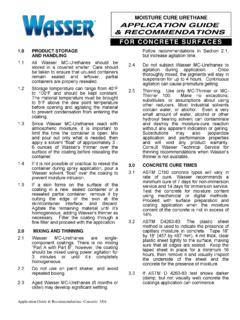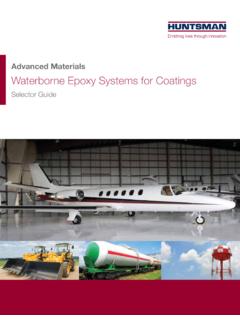Transcription of Material Safety Data Sheet - wassercoatings.com
1 Material Safety data SheetNFPAP rotective ClothingProduct NameSynonymChemical FamilyMC- zinc , , applicable. (Paint)Section 1. Chemical Product and Company IdentificationEMERGENCY PHONE NUMBERS:USA and Canada: 1-800 424-9300 International: 1-703 527-3887 ManufacturerSUPPLIER:Wasser Corporation4118 B PL NW, Suite BAuburn, WA 98001, USPhone# 253-850-2967 HCS Risk PhrasesHCS CLASS: CLASS: Irritating CLASS: Sensitizing CLASS: Target organ CLASS: Flammable liquid having a flash point lower C (100 F).320 Page: 1 Section 2. Composition and Information on IngredientsDate Originated: 2/21/2014In case of EmergencyZinc7440-66-660-100 TWA: 10 (mg/m3) fromACGIH (TLV)Not MDINot disclosed5-10 Not aromatic solvent naphtha(petroleum)64742-95-65-10 TWA: 50 (ppm) from ACGIH(TLV)DERMAL (LD50): Acute:4000 mg/kg [Rabbit].
2 VAPOR (LC50): Acute:10200 ppm 4 hour(s) [Rat].Xylenes1330-20-71-5 TWA: 100 STEL: 150 (ppm)from OSHA (PEL)ORAL (LD50): Acute: 4300mg/kg [Rat]. DERMAL(LD50): Acute: 2000 mg/kg[Rabbit]. VAPOR (LC50):Acute: 6700 ppm 4 hour(s)[Rat].Hydrous calcium magnesium silicate mix14807-96-61-5 TWA: 2 (mg/m3) fromACGIH (TLV)Not oxide (In only)1309-37-11-5 TWA: 5 (mg/m3) fromACGIH (TLV)ORAL (LD50): Acute: 10000mg/kg [Rat].Isocyanic acid, polymethylenepolyphenylene ester9016-87-91-5 TWA: CEIL: (ppm) from ACGIH (TLV)TWA: (mg/m3) fromACGIH (TLV)ORAL (LD50): Acute: 10000mg/kg [Rat]. DERMAL(LD50): Acute: 6000 mg/kg[Rabbit].
3 VAPOR (LC50):Acute: 103 ppm 4 hour(s)[Rat].Diphenylmethane-4,4'-diisoc yanate101-68-80-1 TWA: (ppm)ORAL (LD50): Acute: 10000mg/kg [Rat]. DERMAL(LD50): Acute: 10000 mg/kg[Rabbit]. VAPOR (LC50):Acute: 36 ppm 4 hour(s) [Rat].NameCAS #TLV/PEL% byWeightLC50/LD50 Section 3. Hazards IdentificationPotential Chronic HealthEffectsPotential Acute Health EffectsRoutes of Entry:Inhalation. Skin contact (absorption). Eye contact. or spray mist may severely irritate eyes. Inflammation of the eye is characterized by redness,watering, and product may irritate skin upon contact. Harmful if absorbed through the skin.
4 May cause skinsensitization. Skin inflammation is characterized by itching, scaling, reddening, or, occasionally, in case of ingestion. Irritation or chemical burns of the mouth, pharynx, esophagus andstomach can develop following ingestion of this product. May cause headaches, weakness, nausea,vomiting and diarrhea. Even small amounts of liquid aspirated into lungs during ingestion or fromvomiting may cause mild to severe pulmonary injury and possibly if inhaled (irritant, sensitizer). Over-exposure by inhalation of the vapors/spray mist may producesevere irritation of respiratory tract, characterized by coughing, choking, or shortness of breath.
5 Maycause nausea, headaches and dizziness. May cause lung sensitization by inhalation. Massive exposurecan cause unconciousness or :Skin:Ingestion:Inhalation:Repeated or prolonged contact with spray mist may produce chronic eye skin exposure can produce local skin destruction, or dermatitis, possibly be fatal if or prolonged inhalation of vapors/spray mist may lead to chronic respiratory irritation. Maycause sensitization by :Skin:Ingestion:Inhalation:DO NOT induce vomiting. Have conscious person drink several glasses of water. Seek immediate ContactSkin ContactHazardous InhalationInhalationIngestionHazardous IngestionCheck for and remove any contact lenses.
6 IMMEDIATELY flush eyes with running water for at least 15 minutes,keeping eyelids open. DO NOT use an eye ointment. Seek medical gently and thoroughly the contaminated skin with running water and non-abrasive soap. Rinse with plentyof running water (15-30 minutes). If irritation persists, seek medical the product gets onto the clothed portion of the body, remove the contaminated clothes as quickly as possible,protecting your own hands and body. Place the person under shower. Wash gently and thoroughly thecontaminated skin with running water and non-abrasive soap. Be particularly careful to clean folds, crevices,creases and groin.
7 Rinse with plenty of running water (15-30 minutes). Seek medical attention. Washcontaminated clothing before the person to rest in a well ventilated area. Loosen tight clothing around the person's neck and waist. Ifsymptoms persist, seek medical advice immediately (show the label when possible).Evacuate the person to a safe area as soon as possible. Loosen tight clothing around the person's neck andwaist. If the person is not breathing, administer mouth-to-mouth resuscitation. Warning: It may be dangerous tothe person providing aid to give mouth-to-mouth resuscitation if the inhaled Material is toxic, infectious orcorrosive.
8 Oxygen may be administered if breathing is difficult. Seek medical NOT induce vomiting. Have conscious person drink several glasses of water. Never give an unconsciousperson anything to ingest. Even small amounts of liquid aspirated into lungs during ingestion or from vomitingmay cause mild to severe pulmonary injury and possibly death. If breathing is difficult, administer oxygen. If theperson is not breathing, administer mouth-to-mouth resuscitation. WARNING: It may be dangerous to theperson providing aid to give mouth-to-mouth resuscitation when the Material is toxic, infectious or mouth-to-mouth contact by using mouth guards or shields.
9 Seek immediate medical 4. First Aid MeasuresHazardous Skin ContactMaterial Safety data SheetProduct Name:MC- zinc chronic effects onHumansSensitive individuals may develop eczema and/or asthma on inhalation of this Material . However, in lightof good industrial hygiene, exposure to any chemical should be kept to a : 2 Flammability of the ProductAuto-Ignition TemperatureThe lowest known value is 527 C ( F) (Xylenes). oxides (CO, CO2), and other toxic compounds (nitrogen oxides, isocyanate vapors and traces ofhydrogen cyanide).The lowest known value is CLOSED CUP: 24 C ( F). (Tagliabue.)
10 OPEN CUP: C (100 F).(Cleveland). (Xylenes)The greatest known range is LOWER: UPPER: 7% (Xylenes)Flammable liquid, insoluble in FIRE: Use DRY chemicals, CO2, soda ash or FIRE: Use water spray or fog. Never direct a water jet in the container in order to prevent any splashingof the product which could cause spreading of the fire. Cool the containers with water spray or fog in order toprevent pressure build-up, autoignition or explosion. Firefighters should be equipped with self-containedbreathing apparatus to protect against toxic and irritating fumes. During a fire, isocyanate vapors and otherirritating, highly toxic gases may be generated by thermal decomposition or in presence of open flames and may travel considerable distance to source of ignition and flash back.











